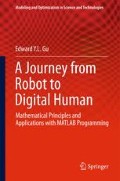Abstract
A rigid body is a theoretical model where any two distinct points on the body (or object) have a fixed time-invariant distance. Otherwise, the object is called a deformable body. In the areas of robotics and digital human modeling research, we often assume that each link of a robotic manipulator or a human body segment (link) is a rigid body, unless it indicates otherwise. A rigid body is relatively easy to be studied in both kinematics and dynamics.
Access this chapter
Tax calculation will be finalised at checkout
Purchases are for personal use only
Preview
Unable to display preview. Download preview PDF.
References
Arnold, V.: Mathematical Methods of Classical Mechanics. Springer, New York (1978)
Marsden, J., Ratiu, T.: Introduction to Mechanics and Symmetry. Springer, New York (1994)
Spong, M., Vidyasagar, M.: Robot Dynamics and Control. John Wiley & Sons, New York (1989)
Murray, R., Li, Z., Sastry, S.: A Mathematical Introduction to Robotic Manipulation. CRC Press, Boca Raton (1994)
Craig, J.: Introduction to Robotics: Mechanics and Control, 3rd edn. Pearson Prentice Hall, New Jersey (2005)
Horn, R., Johnson, C.: Matrix Analysis. Cambridge University Press, New York (1985)
Bretscher, O.: Linear Algebra with Applications, 3rd edn. Prentice Hall (2004)
Jacobson, N.: Lie Algebras. John Wiley and Sons (1966)
Bakhturin, Y.: CampbellHausdorff Formula. In: Hazewinkel, M. (ed.) Encyclopedia of Mathematics. Springer (2001)
Koren, Y.: Robotics for Engineers. McGraw-Hill, New York (1985)
Gu, E.: An Exploration of Orientation Representation by Lie Algebra for Robotic Applications. IEEE Transactions on Systems, Man, and Cybernetics 20(1), 243–248 (1990)
Wehage, R.: Quaternions and Euler Parameters – A Brief Exposition. In: Hang, E. (ed.) Computer-Aided Analysis and Optimization of Mechanical System Dynamics, pp. 147–180. Springer, New York (1984)
Author information
Authors and Affiliations
Corresponding author
Rights and permissions
Copyright information
© 2013 Springer-Verlag Berlin Heidelberg
About this chapter
Cite this chapter
Gu, E.Y.L. (2013). Representations of Rigid Motion. In: A Journey from Robot to Digital Human. Modeling and Optimization in Science and Technologies, vol 1. Springer, Berlin, Heidelberg. https://doi.org/10.1007/978-3-642-39047-0_3
Download citation
DOI: https://doi.org/10.1007/978-3-642-39047-0_3
Publisher Name: Springer, Berlin, Heidelberg
Print ISBN: 978-3-642-39046-3
Online ISBN: 978-3-642-39047-0
eBook Packages: EngineeringEngineering (R0)

